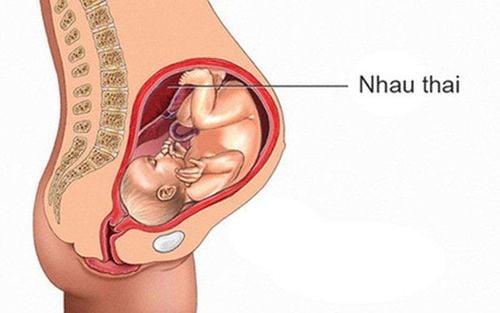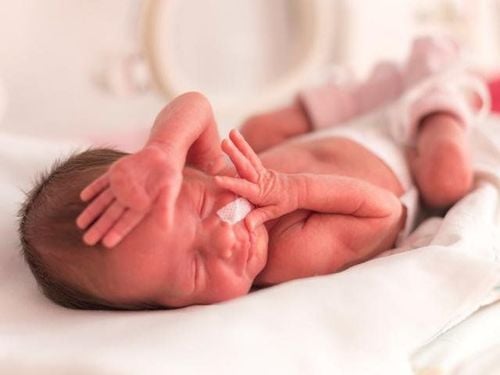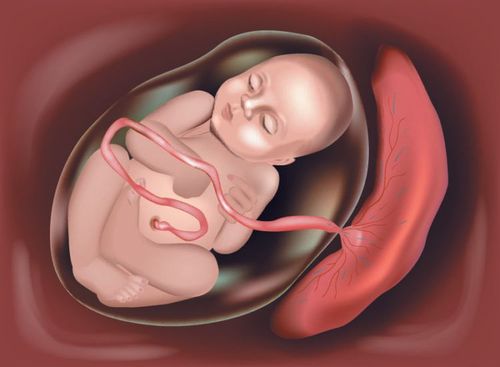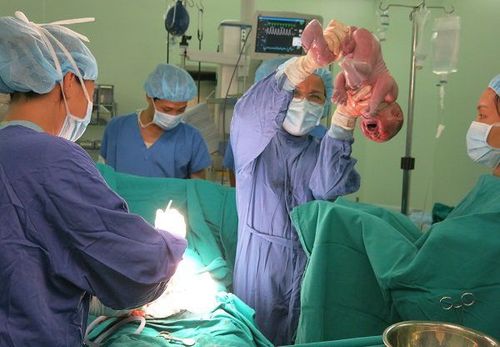This is an automatically translated article.
The article was professionally consulted by Specialist Doctor I Pham Thi Yen - Obstetrics & Gynecology - Department of Obstetrics and Gynecology - Vinmec Hai Phong International General HospitalLow placental attachment is an abnormality of the placenta's attachment position. Depending on the position of the placenta, it can cause many dangers to the mother and fetus.
1. What is low adhesion?
The placenta, also known as the placenta, is an organ that connects the developing fetus to the wall of the uterus that provides nutrients to the fetus through the mother's blood. The placenta at full term weighs about 500 g, usually attached to the anterior or posterior surface or fundus of the uterus.Low placenta is the position where the placenta is not attached to the bottom of the uterus, but a part of the placenta is attached to the lower part of the uterus - near the cervix. The low attachment of the placenta can stop being attached as the gestational age increases and the uterus grows towards the bottom, pulling the placenta up. The position of the placenta can be improved better as the gestational age increases and the uterus grows larger, pulling the placenta towards the fundus of the uterus. Because the placenta is located in front of the fetus's path during vaginal delivery, most cases of low placental attachment require a cesarean section.

2. Signs of low placenta
About the signs to recognize low placenta is during pregnancy, especially in the last 3 months of pregnancy, suddenly pregnant women have unexplained bleeding, not accompanied by abdominal pain, bright red blood after out to freeze into a lump. The amount of bleeding is usually small at first, then the vaginal bleeding may repeat many times, and the next time is often more bleeding than the previous time. In the case of pregnant women who travel a lot, do heavy work, have intercourse, etc., they are more prone to bleeding.
Currently, through ultrasound, in addition to surveying fetal morphology, estimating weight through measurements..., doctors can determine the position of the placenta attached to the uterus, at the fundus, body, and front. , back, low grip, central or semi-central striker placenta.
Therefore, when seeing the above phenomenon, the mother should go to the doctor to detect placenta previa early and take measures to safely handle and reduce the risks for both mother and child.
3. The dangers of each other are low
Low placental adhesion can lead to the risk of bleeding during pregnancy and delivery, endangering the life of the mother and the fetus.
For mothers: due to repeated bleeding during pregnancy, women are often anemic, prone to premature birth. Because the lower uterine segment lacks a sphincter, postpartum hemorrhage often occurs, and the mother may go into shock due to excessive blood loss. In case the placenta is attached to the cervix, after giving birth, the placenta is dissected, causing the cervix to open, easy for bacteria to enter and cause infection. In severe cases, a hysterectomy may be necessary if the placenta, which is firmly attached to the muscle of the uterus, fails to separate from the lining of the uterus. For the fetus: because the mother is anemic due to heavy bleeding, the fetus is at risk of malnutrition and fetal distress. Moreover, due to the mother's excessive bleeding, to ensure the safety of the mother, the doctor is required to have an early cesarean section regardless of whether the pregnancy is full term or not. At that time, the possibility of the infant being premature is very high and the baby is very susceptible to many health problems such as respiratory failure, underweight. In addition, because the placenta is located in the lower part of the uterus, it makes it difficult for the fetus to turn its head down, so it can easily lead to abnormal fetal position (breast or transverse).

4.How to handle each other striker?
When a woman notices vaginal bleeding, she needs to go to the hospital with the nearest obstetrics department to be identified and treated. Depending on the degree of vaginal bleeding and the maturity of the fetus, the doctor will decide to terminate the pregnancy or continue nursing.
If pregnant women receive extra care, pregnant women need to ensure absolute bed rest and nutritious meals. In case the fetus is still preterm and the placenta is low and does not obstruct the exit of the fetus, or if the placenta is attached to the side, clings to the edge or partially covers the cervix, the pregnant woman can stay at home and limit herself to bed. exercise, do not let any small vibrations in the abdomen to avoid stimulating the uterus to cause bleeding, avoid sex, and have antenatal check-ups according to the doctor's appointment. However, if there is no vaginal bleeding and the pregnancy is greater than or equal to 37 weeks, then go to a hospital with an obstetric department so that the mother and fetus can be closely monitored.
Indication for cesarean section is not mandatory for all cases, only cesarean section for the same cases of heavy bleeding previa regardless of gestational age, central placenta previa and mature fetus, when the baby is able to live out of the uterus, the placenta is centrally attached; In cases where the placenta is low or close to the edge, it is possible to give birth vaginally if there are no other abnormalities.
Regarding the prevention of low placental disease, it is best to have family planning, limit multiple births, and do not have multiple abortions.
In the last 3 months of pregnancy, the health of both mother and baby needs to be closely monitored and checked. Pregnant women need:
Know the real signs of labor to get to the hospital in time, affecting the health of the fetus. Differentiate between amniotic fluid and vaginal discharge for timely treatment to avoid premature birth, fetal distress, and stillbirth. Be especially careful when bleeding in the last 3 months of pregnancy needs urgent emergency care to ensure the life of both mother and baby. Monitor the amount of amniotic fluid regularly and continuously. Monitor fetal weight in the last 3 months to assess baby's development and predict possible risks at birth. The special monitoring group is the same as the striker, and the fetal growth retardation needs to be closely monitored by the doctor and given appropriate indications. Distinguish between physiological contractions, labor contractions and mechanical pregnancy to get to the hospital in time. Maternity service package at Vinmec helps pregnant women's pregnancy become lighter and safer. During pregnancy, pregnant women will be examined by top doctors in the Obstetrics and Gynecology Department with high professional qualifications and experience, giving the best advice and treatment for the health of both mother and child. little.
For detailed information about all-inclusive maternity service packages, please contact the hospitals and clinics of Vinmec Health system nationwide.
Please dial HOTLINE for more information or register for an appointment HERE. Download MyVinmec app to make appointments faster and to manage your bookings easily.














